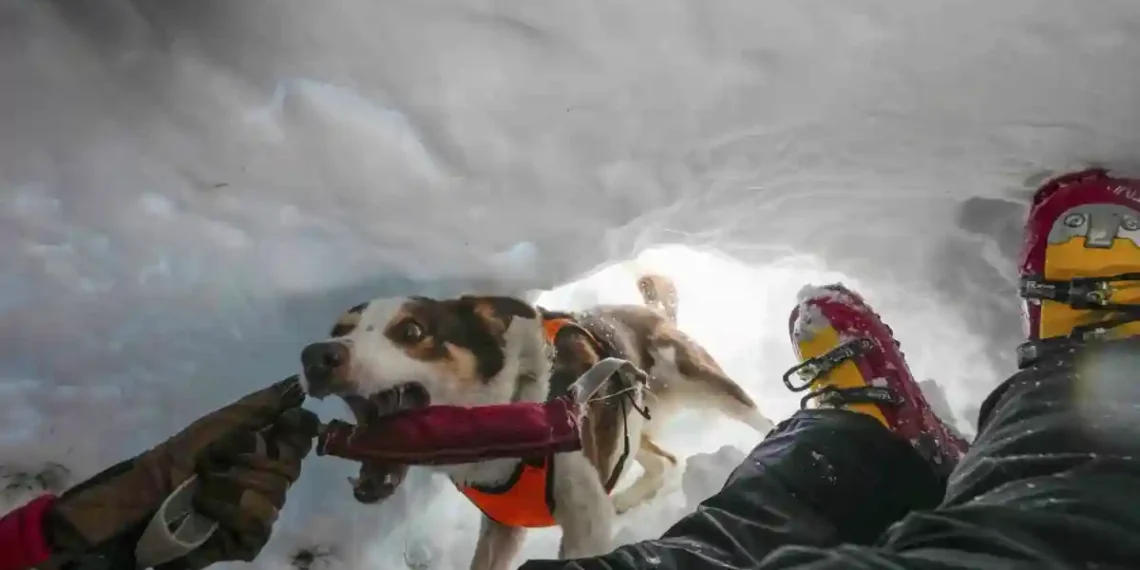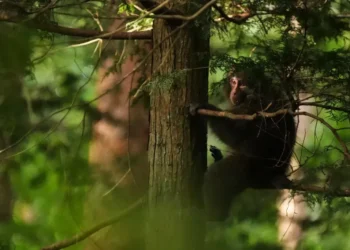Zen the Border Collie: Teaching Other Dogs to Save Lives in Italy’s Avalanche-Prone Dolomites
In the heart of the breathtaking Dolomites, a region known for its jagged peaks and scenic beauty, Zen, a 5-year-old Border Collie, is on a mission — one that could save lives. Zen is not your typical dog. As part of a growing team of avalanche rescue dogs in Italy, Zen plays a pivotal role in locating people buried under snow, helping save lives in one of the world’s most avalanche-prone regions.
On a snowy day above the chic ski resort town of Cortina d’Ampezzo, Zen demonstrates his skills to a group of 20 other dogs in training for avalanche rescue. The air is crisp, the mountains stand tall, and Zen’s swift movements around a snow mound signal to his handler that he’s picked up a scent — someone is buried deep below.
This isn’t just a training exercise; Zen, who has been a rescue dog for three years, is showing others how it’s done. His work is part of an essential effort to train rescue dogs in the Dolomites, an area where avalanches have been claiming more victims in recent years. The number of people caught in avalanches has increased by a staggering 50% over the past 25 years.
As climate change causes heavier, wetter snow to become more common, the risks of avalanches have grown. This kind of snow is especially dangerous for those who are trapped, as it compresses the air pockets that could otherwise allow a victim to breathe. In this environment, trained avalanche rescue dogs are often the first and best chance of survival.
According to Adriano Favre, who runs the canine training camps in Cortina, the ability of a trained dog’s nose to locate buried victims is more accurate than any transponder. They can find people trapped in snow in a way that human rescuers just can’t — making their role in life-saving operations absolutely critical.
Zen’s job is clear: after catching the scent, he finds the “victim,” a volunteer buried in the snow for the exercise. Zen pulls up a rope tug toy, signaling success. His handler, Paolo Sbisa, praises him with a well-earned pat. But this bond between dog and handler is more than just love — it’s vital for their work. As Sbisa says, “Our dogs need to have an intense relationship with the handler. If not, we can’t read what he is trying to tell us.” That connection is the foundation of their life-saving work.
However, not all of Zen’s missions are training exercises. Just days earlier, Zen was part of a real-life rescue on Giau Pass, where a deadly avalanche buried three backcountry skiers.
Zen’s role was vital in this actual rescue. While two of the victims were found using transponders, Zen’s sharp nose was key to locating the third skier, a woman buried 12 feet deep under snow. Unfortunately, despite the efforts, both she and another skier passed away. This tragic outcome underscores a critical truth in avalanche rescues: if a dog is called in, survival is often unlikely.
Rescuers like Sbisa emphasize the importance of having the right safety gear — transponders, probes, and shovels — as the first line of defense. In many cases, self-rescue by those who are with the victim can be the difference between life and death. Dogs, unfortunately, often locate bodies rather than survivors.
The rise in avalanche-related incidents in Italy is alarming. According to the AINEVA snow and avalanche monitoring service, avalanches requiring rescues have doubled since the year 2000, from about 30 to 60 incidents annually. The number of people caught in avalanches has also surged from 65 to 110 each year.
The first 15 minutes after being buried are critical for survival, according to Igor Chiambretti, technical chief of AINEVA. If a person isn’t found within 35 minutes, their chances of survival drop drastically. But rescue efforts are hampered by delays — it takes 15 to 20 minutes for rescuers to reach avalanche sites, and bad weather can stretch this window even further.
There’s hope, however. The introduction of avalanche dogs at ski areas could reduce this response time to just five minutes, potentially saving more lives.
What’s making matters worse is climate change. As warmer temperatures and moisture-laden air create conditions for heavier snowfalls, the risk of avalanches has intensified. Wet snow with higher water content, once a springtime phenomenon, is now common as early as December. This snow is denser and more dangerous, especially in areas like the Italian Alps, where avalanche survival is becoming increasingly difficult.
Gianni Marigo, a climatologist with AINEVA, points out that the Italian Alps are a “hot spot within a hot spot” for climate change, where warming is happening at an accelerated rate. The combination of less snow overall and more dangerous snow conditions has created a perilous situation for both hikers and rescuers.
In a rare and miraculous turn of events, Roberto Ferrino, a backcountry skier, was buried under an avalanche in the northwestern Piedmont Alps for over four hours. By the time he was found, he was well beyond the average survival window. Despite the odds, Ferrino survived, thanks to a lucky air pocket that allowed him to breathe.
While Ferrino doesn’t regret venturing out, he admits that his lack of caution, particularly in choosing a steep slope, was a mistake. His story serves as a stark reminder of the dangers of backcountry skiing — and the vital importance of being prepared.
Zen the Border Collie, along with many other trained avalanche dogs, plays an irreplaceable role in saving lives in Italy’s avalanche-prone mountains. As climate change and more frequent avalanches pose increasing threats, these incredible animals are on the front lines, showing us that sometimes, the difference between life and death is a dog’s nose and a deep bond with its handler.
This article was rewritten by JournosNews.com based on verified reporting from trusted sources. The content has been independently reviewed, fact-checked, and edited for accuracy, neutrality, tone, and global readability in accordance with Google News and AdSense standards.
All opinions, quotes, or statements from contributors, experts, or sourced organizations do not necessarily reflect the views of JournosNews.com. JournosNews.com maintains full editorial independence from any external funders, sponsors, or organizations.
Stay informed with JournosNews.com — your trusted source for verified global reporting and in-depth analysis. Follow us on Google News, BlueSky, and X for real-time updates.














